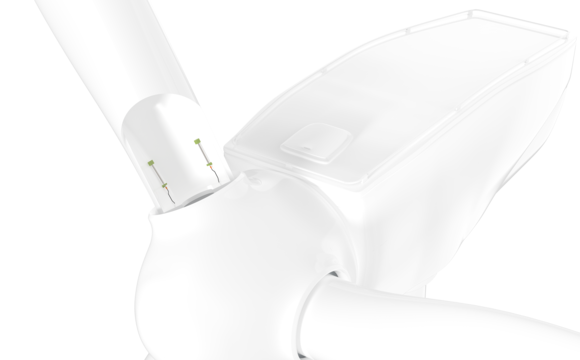
Cantilever Sensor
The most reliable blade load measurement on the market – high-tech performance through and through.
- Lasting reduction of operating and service costs: The use of Cantilever Sensor signals for individual pitch control enables blade load-optimized alignment between turbine design and operating strategy. This significantly reduces the Levelized Cost of Energy (LCoE) in modern turbines.
- Significant sensor and system cost reduction: The Cantilever Sensor‘s simple and robust technology replaces complex and failure-prone sensors, sensitive cables and signal converters on both blade and hub.
- Reliable installation and easy commissioning: The cantilever sensor is quick, simple, and easy to install. The process is completely reliable without the need for sensitive fine tuning.
- Operate your plant without any surprises or unnecessary downtime: Thanks to its simple and robust design, the Cantilever Sensor provides an extremely high-quality, stable signal, which reports the smallest changes clearly and reliably.
- Structural changes and damage can occur on the exposed and extremely expensive wind turbine rotor blades during operation. These issues can, in turn, result in plant failure and downtime.
Cantilever Sensors help to solve these problems by detecting structural anomalies at an early stage, allowing them to be rectified as part of condition-based maintenance before expensive, subsequent damage occurs.
Sometimes, it’s the simple things that are most impressive.
The Bachmann Cantilever Sensor – simple, robust, reliable.
Simple: Using a robust, industry-standard distance sensor, the Cantilever Sensor converts strain measurement into a stable, fault-resistant distance measurement. For example, the measurement signal must not first be transformed from an optical to an electrical signal – a process that is often prone to faults.
Robust: Thanks to its measurement principle, the Cantilever Sensor features a robust design and is easy to install. It also facilitates a very long service and operational life with little maintenance necessary.
Reliable: Despite its very robust design, the Cantilever Sensor acquires extremely accurate and reliable data.
Measurement Principle
The Cantilever Sensor (CLS) measures strain and generates an output signal comparable with an electric strain gauge or fiber-optic strain sensor.
However, due to the principle of inductive displacement measurement, the CLS is not subject to any mechanical deformation.
- The measurement principle guarantees the sensor’s long-term stability.
- The longer reference distance minimizes the influence of local inconsistencies typical of rotor blade composite materials.
- Installation is simple and easy to duplicate.
Detection Function in the Rotor Blade
The Cantilever Sensor can be used in a wide range of applications. For example, the sensor can provide real-time information on blade loads. This makes it ideal for load control purposes, such as IPC (individual pitch control).
The signal is recorded continuously, meaning that the remaining service life can be estimated for each specific plant. The operating and maintenance strategy of entire wind parks can thereby be optimized for the long term, ensuring the highest possible yield. Furthermore, loads on individual blades can be compared, enabling problems such as pitch errors or blade damage to be identified at an early stage. Any necessary corrections and maintenance measures can then be initiated based on this information.
The response time and sensitivity of the Cantilever Sensor enable the easy detection of structural vibrations. Through this detection function and related analysis, structural changes (Anomaly Detection) in the rotor blades can be monitored and assessed.
Application Areas
The Cantilever Sensor is primarily designed to detect blade loads for control purposes, among other things. It has already demonstrated its value in numerous projects, where it has proven easy to handle and reliable during operation.
This versatile solution can also be used to monitor entire structures – from rotor blades to towers. As a result, Bachmann is able to cover the main areas of application in a modern wind turbine with just one smart sensor.
Find out more:
Cantilever Sensor
Download our brochure




